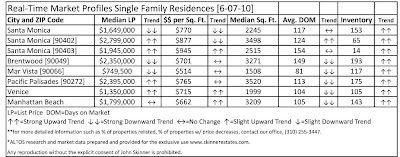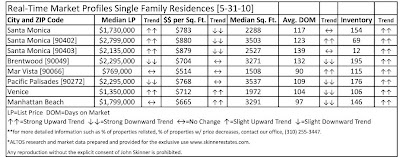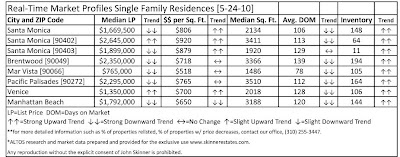Remarkable Interest Rates But New Loan Applications Down 12.2%
That was the message Wednesday from the Mortgage Bankers Assn., which released its survey of last week’s applications for home loans.
An index of refinance activity fell 14.3% and purchase applications were off 5.7% on an adjusted basis.
The lender trade group said purchase applications were still depressed because of the expiration of federal home-buying tax credits at the end of April.
By contrast, refinance applications dropped for the first time in a month despite 30-year mortgage rates averaging 4.8%. (Refis still made up 72% of all mortgage applications.)
“Despite the historically low rates, many homeowners have already refinanced recently, remain underwater on their mortgages, have uncertain job situations, or have damaged credit following this downturn, and therefore may not qualify to refinance,” said Michael Fratantoni, the mortgage group’s vice president of research and economics.
Mortgage rates are being kept low because they tend to track the yield on the 10-year U.S. Treasury bond, which has fallen again because of surging demand for Treasuries, as my colleague Tom Petruno discussed here Wednesday.
The weekly Freddie Mac survey calculates what lenders are offering to people with solid credit and 20% down payments or home equity, and can run slightly higher than what savvy borrowers are able to negotiate. It tracks smaller conforming mortgages, not a jumbo loan such as Thornberg’s.
Freddie said the average 30-year fixed rate was at 4.72% early this week, the lowest level this year and nearly as low as the record for the survey, 4.71%, which was set last December.
The 15-year fixed loan was at 4.17%, the lowest since Freddie Mac began reporting on such loans in 1991. The borrowers would be paying the lender 0.7% of the loan balance in upfront fees and discount points to get the 15- and 30-year fixed rates.
Bel-Air Mansion Goes For Between $50-70 Million…
LA Times Article on mansion that will reportedly sell between $50M and $70M:
So Cal Rents Continue To Fall
Southern California rents, as measured by the Consumer Price Index “CPI”, fell for the seventh consecutive month in April. On a year-over-year basis It’s the longest era of declining rents since the mid-1990s.
April’s rent CPI was down 0.6% from a year ago — slightly smaller declines that we saw in the previous four months. The SoCal rent CPI fell in 17 of 26 months in a period that ended in November 1995. SoCal rents, by this measure, rose steadily on a year-over-year basis from that point until last October — and averaged 4.4% annual growth in that period.
Notes on a Realtor’s Scorecard
-A few quick notes heading into the much needed holiday weekend. I think 2010 can definitely be characterized as the year of the grind for those with jobs and those trying to find work. On the real estate side of things it seems to compute to 1/3 more hours and the deals typically being 1/3 harder to navigate…
Fast Track to Escrow: 331 South Medio in Brentwood went into escrow immediately after the  first broker caravan. The Spanish style home boasts only 2,176 sq. ft. and probably went out around the 2.399 list price…538 14th street in Santa Monica immediately went into escrow around its 2.450 list price. It only lasted 1 day on the market. The 2,866 sq. ft. home needed a little work. . .265 Homewood Road in Brentwood debut on the market this week at $5.195 and had the realtors buzzing during the caravan. Many felt it was priced really well and were threatening to present offers. I imagine this 5,366 sq. ft. home on ½ acre will go for over its asking price.
first broker caravan. The Spanish style home boasts only 2,176 sq. ft. and probably went out around the 2.399 list price…538 14th street in Santa Monica immediately went into escrow around its 2.450 list price. It only lasted 1 day on the market. The 2,866 sq. ft. home needed a little work. . .265 Homewood Road in Brentwood debut on the market this week at $5.195 and had the realtors buzzing during the caravan. Many felt it was priced really well and were threatening to present offers. I imagine this 5,366 sq. ft. home on ½ acre will go for over its asking price.
-The Rich Get Richer: 11 of the 50th wealthiest Angeleanos are from the real estate industry according to the Los Angeles Business Journal. Many of them are builders who have seen net worth jump lately with the recent strength of the market.
-Getting Ready For Summer: The Santa Monica Pier was ranked the fifth most polluted beach in California… Slightly beyond the Santa Monica Pier at the beach near Strand Street, the water is considered part of Heal the Bay’s “honor roll,” meaning that it meets 100 percent of the requirements of water quality standards.
-Pool Party for the Holiday Weekend: Looking for a pool party this weekend? Local hotels like the Shangri-La might be your best bet. Check out this article from the LA Times…
MAKE IT A GREAT MEMORIAL DAY WEEKEND AND REMEMBER TO CELEBRATE THOSE WHO HAVE PROTECTED THIS GREAT COUNTRY!!
Legal Battle in Venice Over Affordable Housing Complex Comes To End
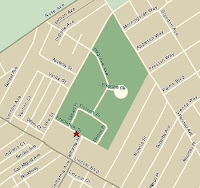
A contentious legal battle involving a rent-controlled apartment complex in Venice that was built after World War II to house veterans unable to find affordable housing has finally come to an end with the Los Angeles City Council’s approval Wednesday of a settlement that will return evicted tenants to their homes.
The council ratified the agreement with AIMCO Venezia, owner of the 38-acre Lincoln Place apartments, located just south of Santa Monica near Rose Avenue. The settlement was reached after 18 months of negotiations.
Under terms of the agreement, AIMCO, will: allow 83 evicted households to return to a rehabilitated Lincoln Place at pre-eviction rental rates; establish a multi-million dollar fund to compensate former tenants not returning to Lincoln Place; and restore 696 vacant apartments to market as rent-controlled units.
AIMCO may also construct up to 99 new rental units with a clubhouse and other recreational facilities on vacant property where the company demolished 99 units in 2003. In a bow to community sentiment, AIMCO and city officials agreed that the height of the new buildings cannot exceed 30 feet and AIMCO waives any right to a density bonus.
Nearly all of the apartments have been vacant for years because of legal entanglements and has been something of an eye-sore for local residents.
The settlement represents the largest-ever restoration of rent stabilized housing in the city’s rental market.
AIMCO, one of the largest real estate management companies in the country, had plans to 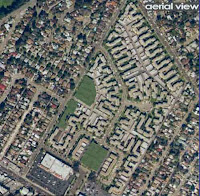 redevelop the property, placing condominiums and luxury apartments on site with 140 low-income units, according to previous reports.
redevelop the property, placing condominiums and luxury apartments on site with 140 low-income units, according to previous reports.
Lincoln Place, a garden-style campus of 52 buildings built in 1951, was originally backed by the Federal Housing Authority when it was built in 1951 to support World War II veterans and their families.
However, it has always been privately owned.
*Sources: Santa Monica Daily Press; Press release from Councilman Bill Rosendahl’s office; The California Registry of Historical Resources
Mortgage Rates: How Low Can They Go? 4.21% for a 15 year mortgage…
Homeowners able to refinance and purchase this week were finding lenders offering 15-year fixed-rate mortgages at an average of 4.21% this week, according to Freddie Mac — the lowest rate since the mortgage company started tracking the 15-year loan in 1991.
Heavy demand for 10-year U.S. Treasury bonds has pushed their yield to the lowest level of the year.
That’s down from 4.84% a week earlier and not far from the record low of 4.71% set back in December.
With mortgage rates near record lows, homeowners are applying to refinance their loans at the highest rate in seven months. The volume of refinancing jumped 17% last week as the average contract rate for a 30-year fixed mortgage sank to 4.80% from 4.83% a week earlier and it was the highest volume since October.
In contrast to the latest refinance boom, applications to purchase homes fell further after a sharp decline the week before. The refinance share of mortgage activity was at 72% of total applications, up from 68% the previous week and the highest refinance in the survey since December 2009.
Industry observers said any home purchasers who could do so completed their transactions by the end of April, when federal tax credits expired for people buying houses.
Freddie Mac gathers information about rates available to well-qualified borrowers who make a down payment of at least 20% or have equivalent equity in their homes if they are refinancing. The borrowers in this week’s survey would have paid 0.7% of the loan balance to the lenders in upfront fees and discount points, Freddie Mac said.
Last year, the experts expected residential mortgage rates would be rising by now, as federal housing and home-loan support programs expired, home prices stabilized and inflation became more of a concern.
Then the latest default scare reared its head — this time involving not U.S. home loans but the debt loads carried by Greece and other weaker European economies. “Just when we thought we were finally experiencing [the anticipated rate increase] we got the PIGS,” said Stew Larsen, head of mortgage banking operations for Bank of the West, referring to an acronym for the nations Portugal, Italy, Greece and Spain.
For those hungry for lower rates, is this the last big chance to head to the trough?
Source: LA Times (Money and Company Blog)



